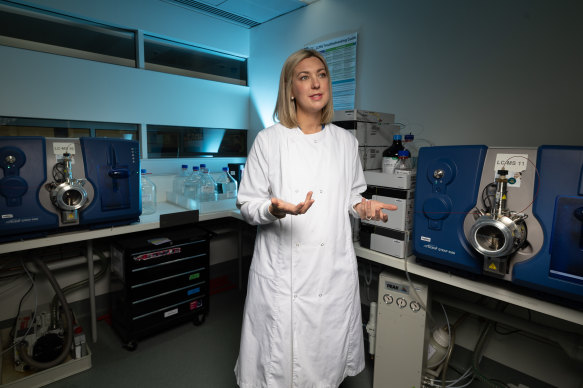- Analysis
- National
- Pill Testing
This was published 6 months ago
Pragmatism, morality and the social science of pill testing
By Liam Mannix
Examine, a free weekly newsletter covering science with a sceptical, evidence-based eye, is sent every Tuesday. You’re reading an excerpt – sign up to get the whole newsletter in your inbox.
Yesterday, we looked under the hood of pill testing: how scientists can tell if a pill really is MDMA.
But as Victoria looks set to approve a trial that would see mobile pill-testing sites up and running by this summer’s festival season, I think the more important story is not the chemistry but the sociology.

What does pill testing do to the way we think about risk?Credit: Richard Giliberto
Does pill testing make drug users more or less likely to take drugs?
Does it make people who otherwise wouldn’t use drugs more or less likely to take them?
And how does it change the risk these two groups face overall?
The evidence
Using drugs comes with a risk of harm.
Evaluating the risk of party drugs is tricky, because MDMA is at the bottom end of the harm spectrum (one famous paper noted the risk of personal harm from taking MDMA is probably lower than horseriding). Fentanyl and opioids, which can contaminate MDMA, are near the top of that spectrum.
“Every drug carries risk,” says RMIT’s Dr Monica Barratt, who studies drug policy. There are varying levels of risk, but “even some of those substances way down the bottom of the list … can still cause people to die”.
Regardless of that, if you increase the amount of drugs consumed, increase the number of people taking drugs, or increase the inherent risk of taking the drugs, you increase the harm they cause.
This is what worries critics of pill testing – that it might create a “false sense of security” and thus increase the number of people taking drugs.
Associate Professor Jennifer Schumann, who has been tapped to advise on the Victorian government’s pill testing program, told me there is “no evidence from anywhere around the world, from 30 years of drug-checking services” that this is true.
Schumann pointed me to several data points:
- A survey at an Australian music festival showed (hypothetical) pill testing would make no difference to people’s choice to take ecstasy or not
- Studies of pill-testing services show few users are first-time users
- Countries with pill testing do not report higher levels of drug use overall
Personally, I find this data surprising. If you could somewhat avoid the risk of contamination, wouldn’t people be more likely to try MDMA?

Jennifer Schumann, the head of the drug intelligence unit at the Victorian Institute of Forensic Medicine.Credit: Jason South
But experts in the field are not surprised. “Anecdotally, young people going to a festival know drugs are dangerous,” Dr Stephen Bright, who has studied this question at Edith Cowan University, tells me. “They are not stupid.”
Other experts argue few people actually want to do psychoactive drugs, or are put off by their illegality.
So, there’s no evidence that drug testing increases the number of people who take drugs. What about the behaviour of people who already take drugs? Does testing mean they will take more?
Far from it. The evidence suggests pill testing actually might reduce the amount of drugs consumed.
In several studies, people reported being less willing to use their drugs if the testing came back with an inconclusive result. Even better, data suggests users respond to big risks, such as being told their pills might contain fentanyl.
This makes intuitive sense. If you go to the bother of getting your drugs tested, you probably want to avoid overdosing on something unexpected.
Barratt makes a third argument: pill test results are often delivered by a health worker who can discuss how to make drug-taking less risky. That cuts the overall risk of taking drugs, even if drugs are still consumed, she argues.
To sum up, the evidence suggests pill testing does not affect overall drug use, and in a high-risk group, it probably somewhat reduces overall use and overall risk.
You can see why people such as Schumann find pill-testing such a compelling policy.
We even have a little bit of data showing it might cut overall harm. In Canada, drug testing at a safe injecting clinic cut the risk of overdose by 41 per cent.
A key point on all this: the evidence quality, overall, is low. That’s kind of what you expect when looking at studies of illegal drugs. If we’re going to pill test, the onus now should be on researchers to conduct high-quality studies – maybe even randomised trials.

Ronald and Nancy Reagan at a rally in 1980. Nancy spearheaded the ‘Just Say No’ to drugs campaign in the 1980s.Credit: Nine
Thinking about risk
We’ve been talking a lot about risk. But risk hasn’t really been central to our drugs policies, says Associate Professor Hassan Vally, a Deakin University epidemiologist who specialises in thinking about risk.
“One might reasonably argue that legal drugs like alcohol and tobacco are more dangerous to our health than some other drugs whose use is criminalised,” says Vally.
Instead, much of our drug policy is based on a community sense of moral outrage. Taking illegal drugs has been viewed as a moral failing. Hence, there is an expectation of abstinence.
But views on drug use are changing. Almost two-thirds of the community now support pill testing. About a quarter of the community has used illegal drugs in the past 12 months. Cannabis is now poorly regulated and readily available.
Putting risk, rather than morality, at the centre of the conversation on drugs changes how you think about policy. Modern life demands we make risk-benefit decisions every day (like getting in a car). And pill-testing advocates view themselves simply as risk pragmatists.
“It’s a normal part of adolescence to take risk,” says Bright. “A young person shouldn’t die as a consequence of making a bad choice.”
Enjoyed Examine, our free weekly newsletter covering science with a sceptical, evidence-based eye? Sign up to get the whole newsletter in your inbox.
correction
An earlier version of this story said Associate Professor Hassan Vally was based at La Trobe University. Professor Vally is now based at Deakin University.